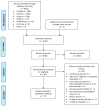A Profile of Injuries Sustained by Firefighters: A Critical Review
- PMID: 31623104
- PMCID: PMC6843477
- DOI: 10.3390/ijerph16203931
A Profile of Injuries Sustained by Firefighters: A Critical Review
Abstract
Firefighters, along with other tactical personnel, are at a high risk of work-related physical injury above that of the private sector. The aim of this critical narrative review was to identify, critically appraise and synthesise key findings from recent literature investigating firefighting musculoskeletal injuries to inform injury reduction programs. The methodological approach (search terms, databases, etc.) was registered with PROSPERO and reported following the Preferred Reporting Items for Systematic Reviews and Meta-Analyses (PRISMA) guidelines. Study quality was assessed using the Downs and Black checklist with scores graded according to the Kennelly grading system. Levels of evidence were ranked according to the Australian National Health and Medical Research Council. Of the 8231 studies identified, 17 met the criteria for inclusion. The methodological quality of the studies was 'fair' with a level of evidence of III-2. Reported injury rates ranged from 9% to 74% with the lower extremities and back the leading aggregated bodily sites of injury. Sprains and strains were the leading nature of musculoskeletal injury, often caused by slips, trips and falls, although muscle bending, lifting and squatting or muscle stressing were also prevalent. This review may inform injury reduction strategies and given that injuries reported in firefighters are similar to those of other tactical populations, safety processes to mitigate injuries may be of benefit across the tactical spectrum.
Keywords: firefighter; fireman; injury; occupational health; tactical.
Conflict of interest statement
The authors declare no conflict of interest.
Figures
References
-
- Walker A., Pope R., Schram B., Gorey R., Orr R. The Impact of Occupational Tasks on Firefighter Hydration During a Live Structural Fire. Safety. 2019;5:36. doi: 10.3390/safety5020036. - DOI
-
- Park H., Kakar R.S., Pei J., Tome J.M., Stull J. Impact of Size of Fire boot and SCBA Cylinder on Firefighters’ Mobility. Cloth. Text. Res. J. 2019;37:103–118. doi: 10.1177/0887302X18807753. - DOI
Publication types
MeSH terms
LinkOut - more resources
Full Text Sources
Medical
Miscellaneous



